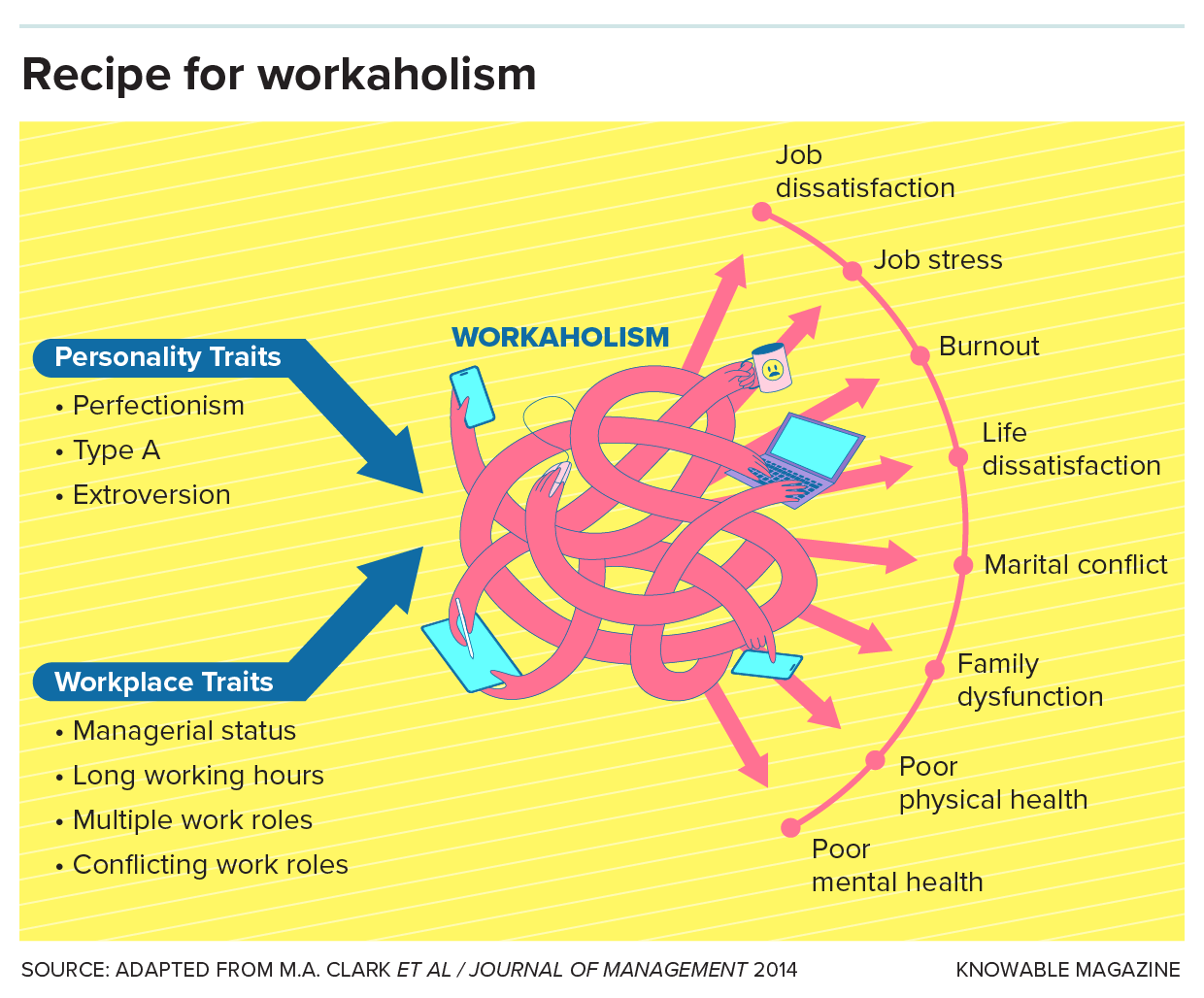Are you a workaholic? Here’s how to spot the signs
In a major shift, psychologists now view an out-of-control compulsion to work as an addiction with its own set of risk factors and consequences
Support sound science and smart stories
Help us make scientific knowledge accessible to all
Donate today
An accountant who fills out spreadsheets at the beach, a dog groomer who always has time for one more client, a basketball player who shoots free throws to the point of exhaustion.
Every profession has its share of hard chargers and overachievers. But for some workers — perhaps more than ever in our always-on, always-connected world — the drive to send one more email, clip one more poodle, sink one more shot becomes all-consuming.
Workaholism is a common feature of the modern workplace. A recent review gauging its pervasiveness across occupational fields and cultures found that roughly 15 percent of workers qualify as workaholics. That adds up to millions of overextended employees around the world who don’t know when — or how, or why — to quit.

Nurses who are workaholics tend to make more errors than their non-workaholic peers.
CREDIT: ISTOCK.COM / JAZZIRT
Whether driven by ambition, a penchant for perfectionism, or the small rush of completing a task, they work past any semblance of reason. A healthy work ethic can cross the line into an addiction, a shift with far-reaching consequences, says Toon Taris, a behavioral scientist and work researcher at Utrecht University in the Netherlands.
“Workaholism” is a word that gets thrown around loosely and sometimes glibly, says Taris, but the actual affliction is more common, more complex and more dangerous than many people realize.
What workaholism is — and isn’t
Psychologists and employment researchers have tinkered with measures and definitions of workaholism for decades, and today the picture is coming into focus. In a major shift, workaholism is now viewed as an addiction with its own set of risk factors and consequences, says Taris, who with occupational health scientist Jan de Jonge of Eindhoven University of Technology in the Netherlands explored the phenomenon in the 2024 Annual Review of Organizational Psychology and Organizational Behavior.
Taris stresses that the “workaholic” label doesn’t apply to people who put in long hours because they love their jobs. Those people are considered engaged workers, he says. “That’s fine. No problems there.” People who temporarily put themselves through the grinder to advance their careers or keep up on car or house payments don’t count, either. Workaholism is in a different category from capitalism.
The growing consensus is that true workaholism encompasses four dimensions: motivations, thoughts, emotions and behaviors, says Malissa Clark, an industrial/organizational psychologist at the University of Georgia in Athens. In 2020, Clark and colleagues proposed in the Journal of Applied Psychology that, in sum, workaholism involves an inner compulsion to work, having persistent thoughts about work, experiencing negative feelings when not working, and working beyond what is reasonably expected.
Some personality types are especially likely to fall into the work trap. Perfectionists, extroverts and people with type A (ambitious, aggressive and impatient) personalities are prone to workaholism, Clark and coauthors found in a 2016 meta-analysis. They had expected people with low self-esteem to be at risk, but that link was nowhere to be found. Workaholics may put themselves through the wringer, but it’s not necessarily out of a sense of inadequacy or self-loathing.

Certain personality traits and workplace traits can foster workaholism, which can lead to poor health and homelife.
From all walks of life
Jack Hassell, a human resources specialist in Christchurch, New Zealand, interviewed 15 self-identified workaholics in that country to get a better sense of their life experiences and motivations. As described in a 2024 article in the International Journal of Organizational Analysis, the workers came from a wide variety of backgrounds and fields — including an athlete, a lawyer and a human-resources professional — but they all ended up in the same predicament.
“Workaholics can exist in any job,” says Clark, who relates her own experiences with obsessed workers — including a kindergarten teacher, a telephone lineman and a former llama rancher — in her book Never Not Working: Why the Always-On Culture Is Bad for Business — and How to Fix It. They may also take different roads. Hassell notes that some of the workaholics in his sample grew up in poverty and felt driven to never go back, while others came from wealth but could never shake the feeling that they should be doing more to get ahead and stay ahead. “The patterns of workaholism are essentially the same, but they arrived there in completely different ways,” he says.
Workaholism crosses demographics too, as Taris and de Jonge detailed in their 2024 overview. Although the literature suggests that workaholic tendencies might be slightly more common in women, older workers and workers with higher levels of education, those associations are weak and inconsistent.
There are some clear risk factors, though. Certain workplaces are more likely than others to foster addictions to the job, Taris and de Jonge report — namely, companies that encourage competition and long hours. They also point to a 2016 survey of over 16,400 workers from Norway that found managers and self-employed workers are more at risk than people who work under someone else’s control.
Workaholism could be on the upswing thanks to Zoom, Slack and every other technological advance that makes it easier for people to work anywhere, anytime, Taris says. “It is something I’m worried about,” he says. “The conditions for workaholism to develop have never been as good as today.”
Clark agrees that the stage seems to be set for more people to find their inner workaholics. “The mass shift to working from home and remote work may have changed some of our communication patterns and expectations,” she says. Working from home, which became especially widespread during the pandemic, likely created a new group of always-on workers who lost all sight of the boundaries between work and home life. It’s troubling, she says. “Even just your average worker might now start to be more of a workaholic.”
Consequences of workaholism
Any worker who slips into workaholic habits may notice some short-term gains — more sales, more overtime pay, more words in the document — but those small victories may be fleeting. Taris, Clark and other experts see a key irony of workaholism: For all of their efforts, those life-on-the-line, have-to-keep-going, never-stop go-getters aren’t necessarily better at their jobs.
In their meta-analysis, Clark and co-authors found no correlation between workaholism and job performance, meaning that workaholics aren’t covering themselves in glory or even separating themselves from the pack. Clark points to a 2015 study showing that people who put in extra-long workdays received roughly the same level of performance reviews as those who only pretended to work similarly long hours. Later investigations — including a 2021 Italian study that tracked evaluations of more than 500 workers over two years — also found little to no correlation between workaholism and performance.
In fact, for some workaholics, a mediocre performance review could be considered a best-case scenario. “They create a lot of work for themselves, but that doesn’t necessarily mean that they’re doing good work,” says Taris. “We know that if people work too hard, they spend little time on recovery.” This, he adds, leads to fatigue and exhaustion — and that increases the likelihood they will make errors that are harmful to the organization, their clients or themselves.
In certain settings, mistakes on the job can be truly dangerous. A 2018 study of 1,781 nurses in Norway tracked the factors that predicted serious work-related incidents, including harming or nearly harming patients, harming or nearly harming themselves, dozing off at work, or breaking equipment. The study found that nurses who were younger or male were especially likely to make certain types of mistakes, but there was another trait that raised the stakes even more: Workaholics were consistently more likely than their co-workers to commit every type of error tracked by the study.
Clark’s 2016 analysis, which compiled results from 89 other studies, found consistent evidence that workaholics suffer impacts far beyond the workplace. For example, a 2006 study of 174 white-collar workers in the United States and Canada found a correlation between workaholism and life dissatisfaction. The higher a person scored on a workaholism scale, the less they enjoyed life. A 2004 study separated 5,853 full-time workers in Belgium into eight categories, including work enthusiasts, work addicts, relaxed workers and disenchanted workers. The work addicts reported more health complaints than any other group. Work enthusiasts, in contrast, reported practically no health complaints, a reminder of the vast difference between addiction and enjoyment.
In her many interviews with workaholics, Clark has seen how overcommitment to the job can go hand-in-hand with unhealthy lifestyles, including excessive drinking and failing to get enough exercise or sleep. For her book, she interviewed a retired social worker who said her obsession with work literally kept her up at night. “It felt like my head was working all night long,” the retiree reported. The former llama rancher, meanwhile, told Clark that she wouldn’t allow herself to eat or relieve herself until her work goals were met, even if that meant hunger and discomfort. “I just had to get that stuff done, or I would feel like I was no good.”
Hassell interviewed an academic who got a wake-up call during the massive Christchurch earthquake of 2011. When the earthquake started, they were reluctant to quit work and leave their desk, Hassell says. Finally forced to exit the shaking building, the academic had an epiphany. “They realized, ‘Oh my God, I was so consumed with work I was willing to almost die.’”

People from many professions — including llama ranchers — can slip into workaholism.
CREDIT: CAVAN IMAGES / ALAMY STOCK PHOTO
How to curb workaholism
There are certain conditions under which workaholics can thrive, though these are not the lives of the average worker. A 2024 study of 300 psychology students in Germany — over 90 percent of them female — found that workaholics actually fared better physically and emotionally than their less-driven classmates during a six-month span. Lead author Nina Junker, a work psychologist at the University of Oslo in Norway, points out that students have well-defined short-term goals and built-in breaks between semesters. “If they go above and beyond, they have opportunities to recover and recharge their batteries,” she says.
Even though workaholics in the real world generally can’t count on summer breaks, they can, at least, help themselves by scheduling downtime. Built-in recovery opportunities are helpful, Junker says. People who have trouble shutting down from work should try visualizing or memorizing all of the day’s achievements, she adds. “That makes it easier to call it a day and enjoy one’s leisure time.”
So far, Taris says, no interventions have been scientifically proven to reliably cure workaholism. There’s still no single, silver-bullet solution, he says. Still, there may be ways to blunt the worst consequences. A 2020 study of 400 working adults in the US found that workaholics who also practiced mindfulness — the ability to be aware of their emotions at any given time — were less likely to suffer from negative moods such as irritation and distress.
In their review, Taris and de Jonge point to some common-sense steps for workplaces to help employees find more balance. They include checking on work hours and reaching out to anyone who goes too far for too long; limiting access to work-related materials after work hours; and encouraging upper management to model healthy approaches to work. A 2023 study of nearly 9,300 salaried workers at small-to-medium companies across Europe found that “soft controls” — management practices that encourage autonomy and empowerment — can reduce the incidence of workaholism and burnout.
But if workaholics truly want to keep working past the point of no return, Taris says there’s not much anyone can do to stop them. Friends and family members can make their pleas, and bosses and companies can change their policies, and some workaholics might see the light and scale back. Or they might be too busy writing one more email.
10.1146/knowable-072324-1
TAKE A DEEPER DIVE | Explore Related Scholarly Articles




